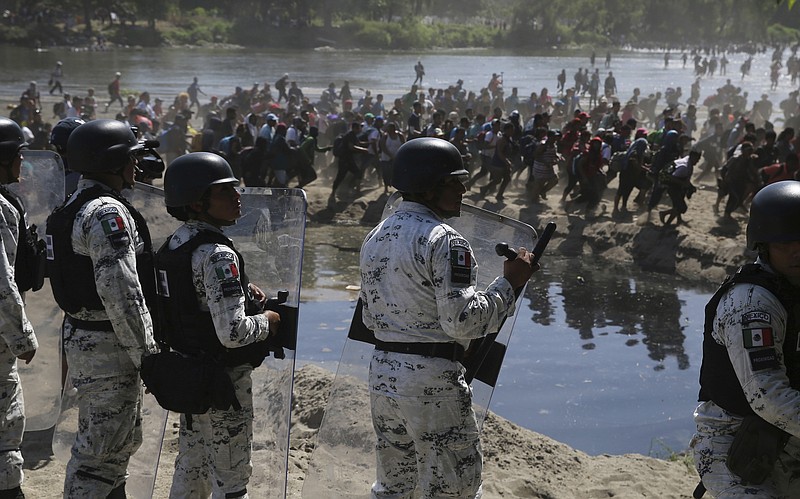CIUDAD HIDALGO, Mexico (AP) — Hundreds of Central American migrants waded across the Suchiate River on Monday into southern Mexico in a new test of U.S. President Donald Trump’s Central America strategy to keep them away from the U.S. border.
The migrants moved off the border bridge and toward the river after Mexican officials told them they would not be granted passage through the country.
Amid shouts and even some fireworks they began wading across the shallow river.
On the Mexican side, migrants ran from side to side along the river bank, kicking up dust and looking for an opening in the ranks of National Guard troops sent to meet them.
Guardsmen scrambled too, trying to head off groups and detaining people where they could. There was pushing and shoving. Some guardsmen carried plastic riot shields hit with rocks tossed by migrants and they occasionally zipped a rock back into the crowd. Others jogged to get into position with long staffs. Still others carried assault rifles.
Many migrants moved back to the river’s edge and a smaller number crossed back to Guatemala.
“You have two options: you go back to Guatemalan territory or you come with us,” Mexican immigration agents said to migrants who had crossed the river. They assured those who went with them that they would “regularize” their status, but few of the migrants believed them.
“Mexico’s president said he would give us work and an opportunity and look,” said Esther Madrid, a Honduran vendor who left her six children in Honduras. Sitting on a rock among dozens of people who didn’t know what to do next, she offered only one word when asked if she would consider returning to San Pedro Sula: “Never.”
By early afternoon, the stalemate resumed, the difference being that the migrants were now on the Mexican side of the river.
Riot police with shields also appeared on the Guatemala side of river, raising questions about what options really remained for the migrants.
Occasionally a few migrants would try to run through a break in the ranks of Mexican guardsmen, but most rested, waiting to see what would happen next.
Daisy Pérez, 42, traveling with two children used the break in the action to call a relative: “We’re in Mexico, send us money.”
The migrants want free passage across Mexico to the U.S. border and Mexico’s government Monday rejected that.
While the government said the migrants are free to enter — and could compete for jobs if they want to stay and work — in practice, it has restricted such migrants to the southernmost states while their cases are processed by a sluggish bureaucracy. Those who do not request asylum or some protective status would likely be detained and deported.
A letter relayed to the migrants Monday by an official of Mexico’s immigration agency restated the Mexican government’s position the migrants would be allowed to enter in orderly fashion, while rejecting free passage.
Edwin Chavez, a 19-year-old from Tegucigalpa, said, “By river, that’s the way it will be.”
“There’s no fear,” Chavez said. “We’re already used to repression. In your country they repress you, they hit you. It’s always like that.”
Earlier, a migrant who refused to give his name stood near the shuttered gates on the bridge over the Suchiate River and read an open letter from the group to President Andres Manuel Lopez Obrador.
“We have come peacefully to try to start a dialogue with the government, in order to reach an agreement in which all the members of the caravan will be allowed permission to freely pass through Mexican territory,” he read.
Trump has forced asylum seekers to remain in Mexico, or apply in Central American countries, effectively removing one of the escape valves for previous caravans. Under threats of trade or other sanctions from the Trump administration, Mexico has stopped an earlier practice of allowing migrants to cross its territory unimpeded.
The Guatemala government issued new data Monday showing 4,000 migrants crossed into the country through the two primary crossings used by the migrants last week, and during the weekend nearly 1,700 entered Mexico at two crossings. It said 400 were deported from Guatemala.
After two caravans successfully reached the U.S. border in 2018 and early 2019, Mexico began cracking down, and by April 2019 raided the last attempt at a caravan, rounding up migrants as they walked down a highway.
As this week’s caravan approached, Mexico sent soldiers to patrol its southern border and monitored the area with drones. Migrants sometimes travel via caravan because it provides safety in numbers and offers a chance for migrants too poor to pay smugglers.
More than 1,000 migrants opted to give Mexico a try Sunday, and were transported by van to immigration centers for further processing.

